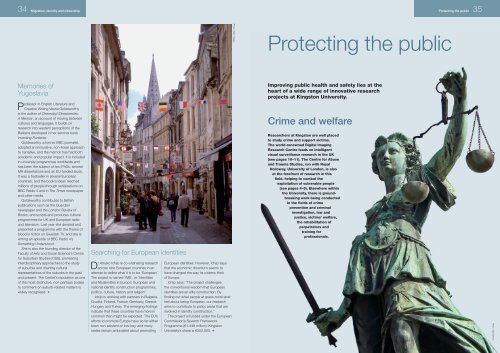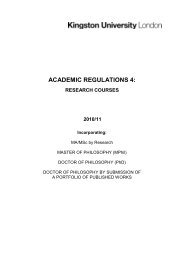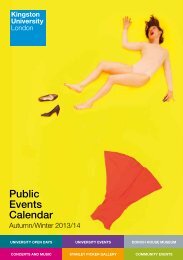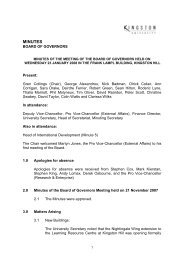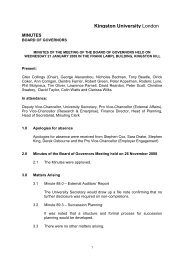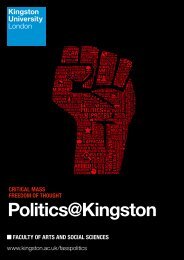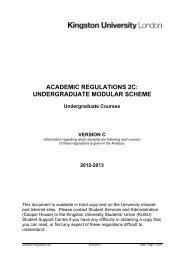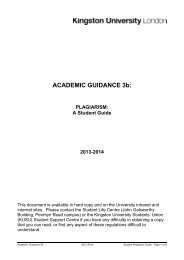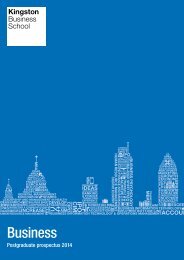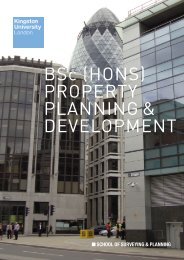Kingston research - Kingston University
Kingston research - Kingston University
Kingston research - Kingston University
You also want an ePaper? Increase the reach of your titles
YUMPU automatically turns print PDFs into web optimized ePapers that Google loves.
18 Collaborations Collaborations<br />
19<br />
Hampton Court Palace<br />
A history of visiting<br />
Royal connections<br />
<strong>Kingston</strong> <strong>University</strong> has undertaken a number of<br />
successful collaborative projects with Historic Royal<br />
Palaces, a charity responsible for the Tower of<br />
London, the Banqueting House, Kensington Palace,<br />
Kew Palace and also Hampton Court Palace, which<br />
is located close to <strong>Kingston</strong> upon Thames.<br />
Recently, <strong>research</strong>ers helped to update Hampton<br />
Court’s presentations on King Henry VIII as part of<br />
the celebrations of the 500th anniversary of his<br />
accession to the throne in 1509. Their work helped<br />
to increase the numbers of visitors to the Palace<br />
and consequently its income.<br />
In 2006, <strong>Kingston</strong> <strong>University</strong> was awarded<br />
funding for a three-year Knowledge<br />
Transfer Partnership (KTP) by the Arts<br />
and Humanities Research Council<br />
(AHRC) to employ KTP Associate Susannah<br />
Lipscombe as a <strong>research</strong> curator based<br />
at Hampton Court Palace. Susannah’s<br />
<strong>research</strong> drew on literary historian Professor<br />
Thomas Betteridge’s <strong>research</strong> on the<br />
Tudor court, and was supervised by<br />
Senior Lecturer in English Literature Erica<br />
Longfellow, both of whom have worked<br />
closely with the Palace.<br />
The KTP project aimed to redesign the<br />
way that visitors experience the Tudor<br />
sections of Hampton Court. The new<br />
interpretation was titled ‘Henry VIII: Heads<br />
and Hearts’. Lipscombe wrote text for a<br />
range of media to immerse visitors in<br />
Henry’s world, and included displays,<br />
publications, audio guides, a website and<br />
a Twitter feed, ‘I am Henry VIII’. She also<br />
designed new visitor costumes and Tudorinspired<br />
warders’ uniforms, and briefed<br />
staff and volunteers on the latest <strong>research</strong><br />
findings. For example, she explained how<br />
the Privy Council worked, who was present<br />
and what they discussed, which enabled<br />
the Council Chamber to be opened to the<br />
public (for the first time) with an innovative<br />
multimedia display that immerses visitors in<br />
key debates of the time.<br />
In addition, Lipscombe implemented a<br />
strategy to build links with the <strong>research</strong><br />
community. She set up an interdisciplinary<br />
Research Advisory Panel and organised a<br />
successful conference on Henry VIII, cosponsored<br />
by the <strong>University</strong>, and a series of<br />
public talks. She published a book, 1536:<br />
The year that changed Henry VIII; is coediting<br />
Henry VIII and the Tudor Court with<br />
Betteridge, and wrote a paper on her<br />
experience of bringing history to the public<br />
for The Public Historian.<br />
These initiatives contributed to a<br />
significant increase in Hampton Court’s<br />
income. Between April and September<br />
2009, there were an additional 115,287<br />
visitors to the palace, up 43 per cent on the<br />
same period in the previous year, compared<br />
with a 12.8 per cent increase in visitors to<br />
other comparable attractions. Importantly,<br />
the number of domestic visitors increased<br />
sharply; local and domestic repeat visitors<br />
are considered crucial for community<br />
engagement and stabilising income<br />
streams.<br />
Dr Lucy Worsley, Chief Curator for<br />
Historic Royal Palaces, said the innovative<br />
KTP with <strong>Kingston</strong> <strong>University</strong>, and the<br />
resulting exhibition, had been “...a huge<br />
success economically and culturally. It has<br />
helped to boost our visitor numbers to the<br />
highest level for a decade, and that income<br />
is crucial to ensuring Hampton Court Palace<br />
is looked after and kept open for people all<br />
over the world to visit.”<br />
The project was funded by the AHRC for<br />
£170,502. ◆<br />
Dr Julia Parker recently completed<br />
an AHRC-funded collaborative<br />
doctoral <strong>research</strong> project which<br />
revealed the fascinating history of<br />
Hampton Court Palace’s first 100 years<br />
as a visitor attraction.<br />
From 1838–1938, Hampton Court<br />
Palace was transformed from a<br />
building in which to present the<br />
paintings of the royal collection into a<br />
historic environment in its own right.<br />
Parker’s thesis, ‘Reinvention and<br />
continuity in the making of an historic<br />
visitor attraction: control, access and<br />
display at Hampton Court Palace,<br />
1838–1938’, enhanced understanding<br />
not just of the Palace, but also of<br />
historical and contemporary discourses<br />
of heritage, architectural conservation,<br />
preservation, display and museology.<br />
This <strong>research</strong> has enabled Hampton<br />
Court to become more aware of its<br />
curatorial practice and to determine<br />
how best to present the Palace as<br />
visitors’ needs change. The project<br />
also strengthened the <strong>University</strong>’s<br />
partnership with Hampton Court,<br />
increased staff expertise, and provided<br />
a model for future collaborative<br />
doctoral projects.<br />
Parker was attached to the curatorial<br />
team at Hampton Court and<br />
supervised by Dr Trevor Keeble, an<br />
associate director of the Modern<br />
Interiors Research Centre (MIRC);<br />
Professor Fran Lloyd, Director of the<br />
Visual and Material Culture Research<br />
Centre (VMCRC); and Dr Lucy Worsley,<br />
Chief Curator of Historic Royal Palaces.<br />
The project was funded by the<br />
AHRC (£57,489). ◆


